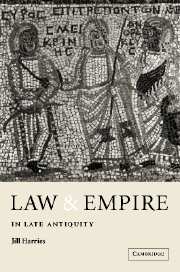Book contents
- Frontmatter
- Contents
- Preface
- Introduction
- 1 The law of Late Antiquity
- 2 Making the law
- 3 The construction of authority
- 4 The efficacy of law
- 5 In court
- 6 Crime and the problem of pain
- 7 Punishment
- 8 The corrupt judge
- 9 Dispute settlement I: out of court
- 10 Dispute settlement II: episcopalis audientia
- Conclusion
- Bibliography
- Index
3 - The construction of authority
Published online by Cambridge University Press: 22 September 2009
- Frontmatter
- Contents
- Preface
- Introduction
- 1 The law of Late Antiquity
- 2 Making the law
- 3 The construction of authority
- 4 The efficacy of law
- 5 In court
- 6 Crime and the problem of pain
- 7 Punishment
- 8 The corrupt judge
- 9 Dispute settlement I: out of court
- 10 Dispute settlement II: episcopalis audientia
- Conclusion
- Bibliography
- Index
Summary
In 370, the local senate at Oxyrhynchus assembled to debate a routine matter. After ‘the acclamations’ (euphemiai), they turned to business. One of their number had lodged a complaint against his appointment as administrator of soldiers’ woollen clothing, on the grounds that, as one of the twenty-four chief decurions, he was exempt, by a regulation of ‘our lord, the most illustrious Tatianus’, Praetorian Prefect of the East. The surviving minutes of the meeting record each casting his vote in turn in favour of their colleague, excusing the nomination on grounds of ignorance, and indulging in extravagant assertions of the rightness of the laws. Having affirmed in unison the validity of the tablet of law, statements were offered by individuals, evoking the authority of Tatianus and the whole senate, then Tatianus, plus his referral of the matter to the emperors and the Praetorian Prefecture, then, finally, ‘what has been approved by the masters of the world and by the lords, the most illustrious prefects’.
The written record was designed to stand as proof, if proof were needed, of the loyalty of this relatively insignificant Egyptian council to its rulers. The effect of the language used in the meeting, which would have been employed regularly, with variations, on such occasions, was to create a tie between the councillors and the far-off emperor, whose attention could be claimed even by so minor a matter as soldiers’ woollens. By invoking the authority (auctoritas) of the emperor, the council gave legitimacy to its own proceedings.
- Type
- Chapter
- Information
- Law and Empire in Late Antiquity , pp. 56 - 76Publisher: Cambridge University PressPrint publication year: 1999

